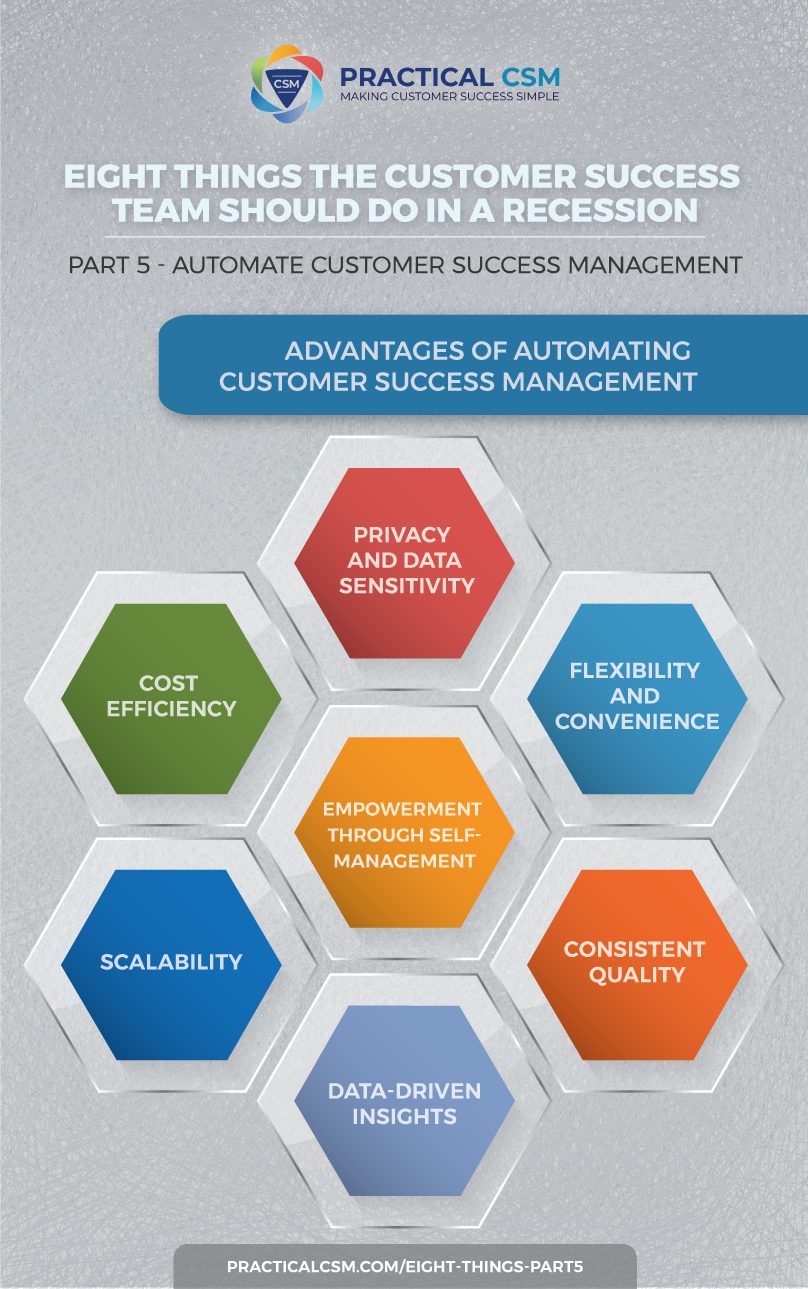Automate Customer Success Management
Eight Things the Customer Success Team Should Do in a Recession – Part 5
Overview
There were a lot of great points made in my recent interview with Nick Mehta, CEO of Gainsight, but there was one aspect of the interview in particular that I think was particularly important. This was the part of our conversation when we discussed the role of the Customer Success Management team during a recession, or during any period of uncertainty where businesses are tightening up budgets and only performing essential activities due to fear of an impending recession, which I think is a good description for the situation we find ourselves in right now.
This article is partially based upon my recent discussion with Nick Mehta, and describes eight practical steps that almost any Customer Success Management team should be able to take when faced with a recession or period of uncertainty. In fact, to be exactly accurate we will discuss seven things to do and one thing to avoid doing. The original interview that inspired this article was recorded and the recording is available from our website here and from our YouTube channel here.
The eight practical steps we will be covering in this article are:
- Proactively Offer Your Help
- Address Your Client’s Current Priorities
- Measure and Prove the Value
- Use Process to Create Efficiency
- Automate Customer Success Management
- Leverage the Power of Client Communities
- Make Your Product an Essential Need
- Do Not Become the Concierge

Automate Customer Success Management
There are several advantages to automation – or what Nick Mehta tends to refer to as “digitalization” if you are following along in the recent interview between he and I that was the inspiration for this article or short series.
Perhaps the first and most commonly cited reason is for economic reasons. For some businesses, it may be possible, but for the majority of companies, it can be difficult to provide a fully staffed Customer Success Management service that reaches all customer segments without being cost-prohibitive. It all hinges on the relative value of your customers’ investments with you. If the profit from an average sale is $1,000 per annum, it might be hard to provide a fully staffed Customer Success Management service that for the sake of argument costs the company $2,000 per annum to provide. We’d actually be losing on the deal and of course, if we carried on like that for long we’d soon go out of business!
So if the fully-staffed version of Customer Success Management simply will not stack up from the financial perspective, what can we do? Well of course we can look to alternatives, including automated CS services (i.e. digital CS services).
As we have seen, the first and often the foremost reason for going down the CS automation route is costs. However, this is not the only potential advantage to be gotten from the automation of at least some parts of your Customer Success Management operations. The next advantage I’d like to discuss with you is the ability for our customers’ stakeholders to manage their own Customer Success Management process. This concept of self-management can be very empowering for some types of customers, especially the more mature ones (i.e. those clients who already know what they are doing to a greater extent).
Whilst not all of our clients are going to fall into this category of “mature users”, it is entirely possible that many clients will do so. This will vary from company to company depending upon what you sell and to whom you sell it. You will therefore need to conduct some research if you are unsure as to which of your customers this category might apply to. Once you have researched them, you effectively have the ability to segment your customer success management services using this as well as other segmentation methods.
So for the mature client, it can come as a refreshing and pleasant surprise when they are provided with a largely automated Customer Success Management service from their supplier. Instead of waiting for services to be offered to them, the “self-service” client can go right ahead and get started as soon as they wish, or delay for as long as they wish until they are good and ready. If they want to utilize Customer Success tools and guidance at 2 a.m. on a Sunday morning then they are perfectly able to do so. No waiting to get hold of a CSM, no scheduling meetings around busy diaries. Nice!
Additionally, they do not need to share what they are doing with their supplier. Perhaps they would rather not discuss certain data or information that a CSM might reasonably think they need to know in order to provide the right guidance. Maybe some of the information is sensitive or even confidential, and there may even be regulations around it for some types of customer organization. Companies in the pharmaceutical and banking industries spring to mind here as classic examples of organizations that do not like to share data and would rather keep the majority at least of their suppliers at arm’s length away from their initiatives. These types of companies might welcome access to an online calculator tool or automated step-by-step online wizard much more than a conversation with a CSM.
The final benefit I want to feature is the benefit of “consistent quality”. Human beings (however well trained and however well qualified) are prone to errors and sometimes when pressed for time they might take shortcuts. Automated services do not tend to display these faults, and are quite contented to provide exactly the same standard of service every time. Of course, to an extent this works both ways, meaning that you had better make sure that the service it delivers is actually a high-quality service in the first place, because otherwise instead of frustrating just one customer you will be frustrating all customers who utilize your automated service. But assuming you get the automation right, this third benefit of consistent quality can be very powerful.
For the reasons described in the last paragraph, I would recommend that brand-new startups put off developing too many intricate automated systems at first. Instead for the startup, I would recommend a more time and cost-intensive manual process at first, which you can use as a learning process. Manual processes are very much easier and cheaper to amend than an automated service that requires programmers to develop it in the first place and then redevelop it if the requirements turn out to not be quite what’s needed. Better therefore to wait a while and learn lessons for what is really needed (as opposed to what we merely think is needed) before asking our developers to create the automated versions.
Stay tuned for Part Six of the “Eight Things the Customer Success Team Should Do in a Recession” article which will be published next month.
Go Back to “Eight Things the Customer Success Team Should Do in a Recession – Part One.”
Go Back to “Eight Things the Customer Success Team Should Do in a Recession – Part Two.”
Go Back to “Eight Things the Customer Success Team Should Do in a Recession – Part Three.”
Go Back to “Eight Things the Customer Success Team Should Do in a Recession – Part Four.”







